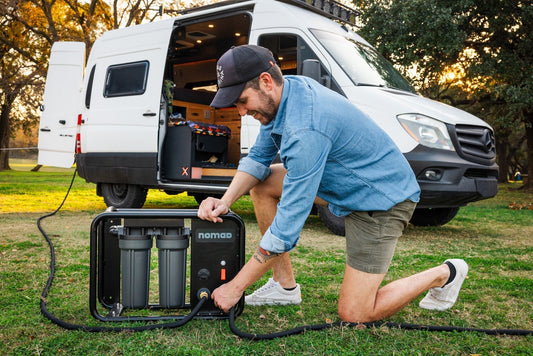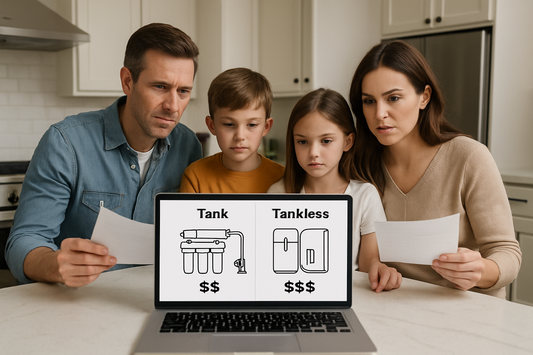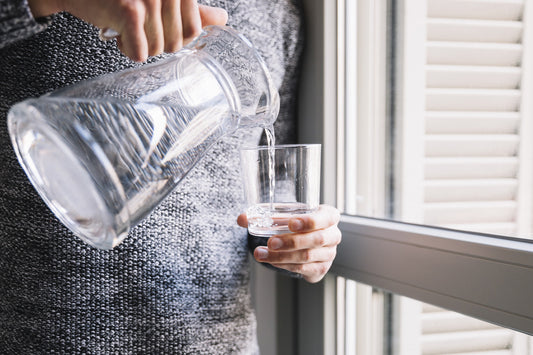The Hidden Danger: Why Your Water Needs a Lead Filter
If your home was built before 1986, there's a significant chance lead is contaminating your drinking water right now. Most homeowners don't realize that even "safe" municipal water can pick up dangerous lead levels as it travels through older pipes, solder joints, and fixtures before reaching your tap.
Here's what you need to know: A quality lead water filter can reduce lead contamination by 95-99%, but only if you choose the right type. Not all water filters remove lead effectively, and some marketed as "lead filters" barely make a dent in contamination levels.
The most effective lead removal systems include:
- Reverse osmosis systems (99% lead reduction)
- Activated carbon filters with lead certification (95% reduction)
- KDF (Kinetic Degradation Fluxion) media (90-95% reduction)
Understanding Lead Contamination in Your Home
Lead enters drinking water primarily through contact with lead-containing plumbing materials. While lead pipes were banned in 1986, millions of homes still have:
- Lead service lines connecting your home to the water main
- Lead solder used in copper pipe joints (common until the 1980s)
- Brass fixtures and faucets containing lead components
- Galvanized pipes that may have lead-contaminated coatings
Even homes with newer plumbing aren't immune. Lead can leach from brass faucets, especially when water sits stagnant overnight or during periods of non-use.
Health Risks You Can't Ignore
Lead exposure affects everyone, but children under 6 and pregnant women face the most severe risks:
In Children:
- Permanent cognitive impairment and learning disabilities
- Reduced IQ and attention span
- Behavioral problems and hyperactivity
- Delayed growth and development
In Adults:
- High blood pressure and cardiovascular disease
- Kidney damage and reproductive issues
- Memory problems and mood disorders
There's no "safe" level of lead exposure. Even small amounts accumulate in the body over time, causing long-term health problems.

Image by hryshchyshen
Which Lead Water Filter Actually Works?
Not all water filtration systems remove lead effectively. Here's what independent testing reveals:
Most Effective: Reverse Osmosis Systems
Lead Removal Rate: 95-99%
Reverse osmosis forces water through a semi-permeable membrane that blocks lead particles. While systems like Pelican whole house filters were popular options, many homeowners are now choosing more accessible alternatives like Crystal Quest reverse osmosis systems that offer comparable lead reduction with better availability and customer support.
Highly Effective: Certified Carbon Filters
Lead Removal Rate: 90-95%
Look for carbon filters specifically certified for lead removal by NSF International. Standard carbon filters may not remove lead effectively. Waterdrop under-sink systems combine advanced carbon filtration with additional lead-removal media for comprehensive protection.
Moderately Effective: KDF Media Filters
Lead Removal Rate: 85-90%
Copper-zinc alloy media creates an electrochemical reaction that removes lead through ion exchange. Often combined with carbon for enhanced performance.
Testing Your Water for Lead
Before investing in a lead filter, test your water to understand your contamination levels:
Professional Testing: Contact a certified laboratory for the most accurate results. Costs typically range from $25-150 depending on the comprehensive analysis.
DIY Test Kits: Home test kits provide quick results for $15-40. While less precise than lab testing, they offer a good starting point for detecting lead presence.
When to Test:
- After periods of non-use (morning first-draw samples)
- If you notice metallic taste or discolored water
- Before purchasing a filtration system
- Annually if you have older plumbing

Image by vershinin89
Installation and Maintenance: Getting the Most from Your Lead Filter
Whole House vs. Point-of-Use Systems
Whole House Lead Filters:
- Protect all water entering your home
- Higher upfront cost but comprehensive coverage
- Ideal for homes with lead service lines
- Require professional installation
Under-Sink Lead Filters:
- Target drinking and cooking water specifically
- More affordable and easier to maintain
- Perfect for targeted protection
- DIY installation possible
Maintenance Requirements
Replace filter cartridges according to manufacturer specifications - typically every 6-12 months. Overused filters can actually release accumulated contaminants back into your water.
Monitor system performance with periodic testing to ensure continued effectiveness.
Making the Right Choice for Your Family
Consider these factors when selecting a lead water filter:
Water Usage: High-volume households benefit from whole house systems
Contamination Level: Severe contamination requires reverse osmosis
Budget: Point-of-use systems offer protection at lower cost
Installation Preferences: DIY-friendly vs. professional installation
For most families dealing with moderate lead contamination, a certified under-sink lead filter provides excellent protection for drinking and cooking water at a reasonable cost.
While legacy brands like Pelican Water Systems built strong reputations in lead filtration, current market leaders like Crystal Quest and Waterdrop offer more accessible solutions with proven lead removal capabilities and readily available replacement parts.
Frequently Asked Questions
How do I know if my water filter removes lead? Look for NSF/ANSI Standard 53 certification specifically for lead reduction. Generic water filters may not remove lead effectively, even if they improve taste and odor.
Can boiling water remove lead contamination? No, boiling water concentrates lead rather than removing it. As water evaporates, lead concentrations actually increase, making the problem worse.
How often should I replace my lead water filter? Replace cartridges according to manufacturer guidelines, typically every 6-12 months or after filtering the specified gallon capacity. Set calendar reminders to avoid overuse.
Are expensive lead filters always better? Price doesn't guarantee performance. Focus on NSF certification for lead removal and choose systems sized appropriately for your household's water usage and contamination levels.





